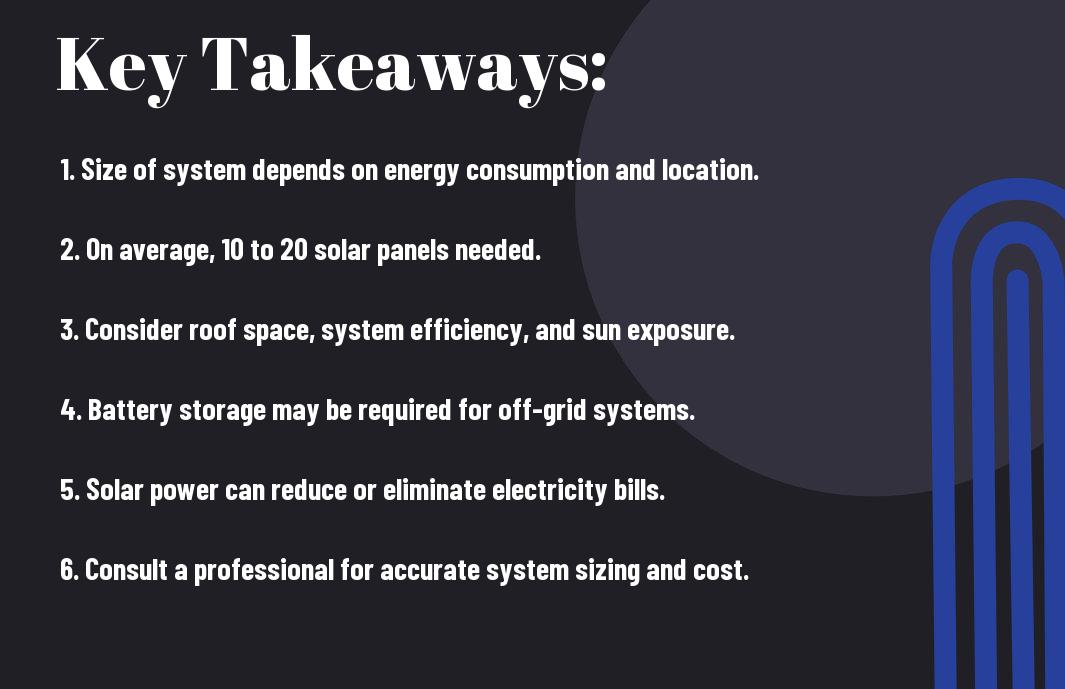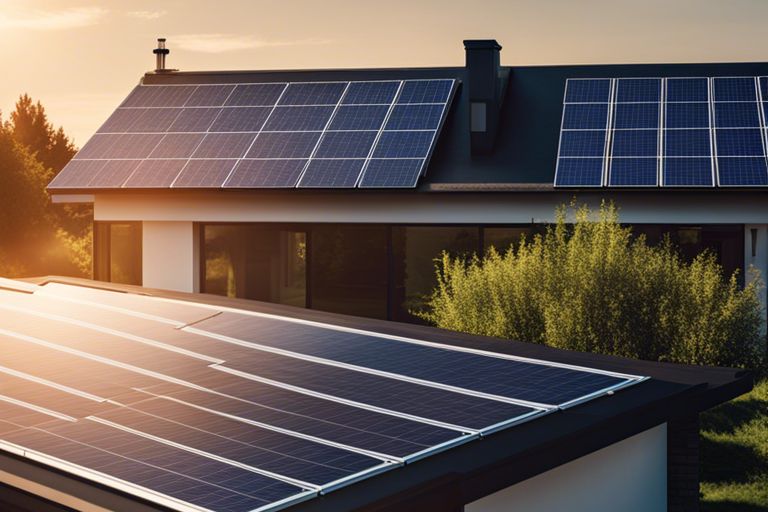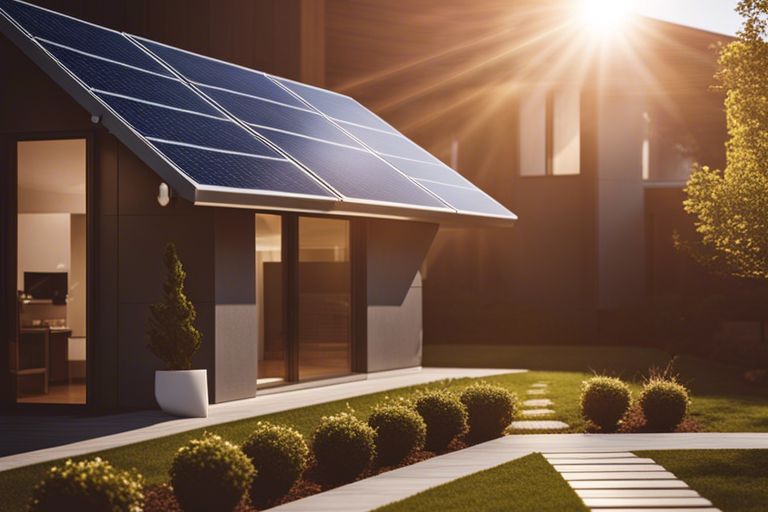With the increasing focus on renewable energy sources, you may be wondering just how much solar power you need to sustain your household energy needs. In this informative guide, we will explore the factors that influence the amount of solar energy required to power a typical house, from location and roof size to energy consumption habits. By the end, you will have a clearer understanding of how much solar power it takes to make your home more sustainable. Let’s initiate on this solar journey together.
Key Takeaways:
- Solar panel size: The size of the solar panel system needed to power a house depends on various factors such as energy consumption, location, and efficiency of the panels.
- Energy production: On average, a 2,000 square feet house may require a 6 kW solar panel system to meet its electricity needs.
- Location impact: The amount of sunlight received in a specific location directly affects the amount of energy produced by the solar panels.
- Energy storage: Installing a battery storage system can help in storing excess energy generated by the solar panels for use during low sunlight periods or at night.
- Return on investment: While the initial cost of installing solar panels may be high, the long-term savings on energy bills can result in a good return on investment.

The Basics of Solar Power
What is Solar Energy?
Power your home with the abundant energy of the sun by installing solar panels. To find out how many solar panels you need for your home in 2024, you can check out How Many Solar Panels Do I Need For My Home In 2024? for personalized recommendations.
How Does Solar Power Work?
To harness the power of the sun, solar panels are used to capture sunlight and convert it into electricity for your home. The process starts when the panels absorb sunlight and create direct current (DC) electricity. This electricity then passes through an inverter, which converts it into alternating current (AC) electricity that can be used to power your home.
Understanding the basics of how solar power works is important for realizing its potential in powering your home. Solar panels play a crucial role in capturing sunlight and converting it into usable electricity, providing a sustainable and renewable energy source for your household needs.

Assessing Your Energy Needs
Now let’s explore assessing your energy needs to determine how much solar power you would need to power your house. This step is crucial in designing a solar system tailored to your specific requirements.
Calculating Your Energy Consumption
Your first step is to calculate your energy consumption. Look at your electricity bills to determine how many kilowatt-hours (kWh) you are using each month. You can also use online tools to estimate your energy usage based on the appliances and electronics you have in your home. By understanding your average daily and monthly energy consumption, you can better gauge how much solar power you need to generate to meet your needs.
Factors Affecting Energy Usage
- The size of your home: Larger homes generally require more energy to heat, cool, and power.
- The climate you live in: Extreme temperatures can increase your energy usage for heating and cooling.
- The energy efficiency of your appliances and home: Upgrading to energy-efficient appliances and improving insulation can reduce your energy consumption.
Consumption patterns also play a significant role in your energy needs. For example, if you work from home and use electronics throughout the day, your energy consumption will be higher than someone who is out of the house most of the day. Understanding these factors will help you determine the right solar system size for your household.
The key is to accurately assess your energy needs and consumption patterns to size your solar system effectively. By taking into account these factors, you can ensure that your solar installation meets your energy requirements and helps you save on your electricity bills.

Sizing Up Your Solar System
Determining Your Solar Panel Requirements
After assessing your household energy needs and considering factors like location and sun exposure, you can determine how many solar panels you will need to power your home. To calculate this, you’ll need to know your average daily energy consumption in kilowatt-hours (kWh) and the efficiency of the solar panels you plan to install.
Considering System Efficiency and Losses
Considering system efficiency and potential losses is crucial when sizing up your solar system. Factors such as shading, orientation, and temperature can impact the efficiency of your solar panels. It’s important to choose high-quality panels and work with a reputable installer to minimize energy losses and maximize the performance of your system.
System efficiency refers to how well your solar panels convert sunlight into usable electricity. By selecting efficient panels and optimizing their placement, you can ensure that your system generates as much power as possible to meet your household’s energy needs.
Roof Size and Orientation Matters
Evaluating Your Roof’s Solar Potential
Roof size and orientation play a crucial role in determining how much solar energy your house can harness. For optimal solar power generation, you need to evaluate your roof’s solar potential. Factors such as the pitch, azimuth, and shading of your roof will impact the efficiency of your solar panels.
Optimizing Roof Orientation for Solar
One important consideration when it comes to maximizing your roof’s solar potential is optimizing its orientation. For most locations in the Northern Hemisphere, a south-facing orientation is ideal for capturing the maximum amount of sunlight throughout the day. However, depending on your specific location and roof characteristics, an east or west-facing orientation could also be beneficial to generate solar power effectively.
Potential shading from nearby structures or trees can also impact the efficiency of your solar panels. It’s crucial to minimize any obstructions that could block sunlight from reaching your roof, ensuring that you can make the most of your solar energy system.
Local Climate and Weather Conditions
How Weather Patterns Affect Solar Energy Output
All around the world, the amount of sunlight your solar panels receive can be influenced by local weather conditions. Cloud cover, rain, and even pollution in the air can affect the intensity of sunlight reaching your solar panels. In areas with frequent overcast skies or heavy rainfall, your solar panels might not be able to generate as much energy as in sunnier regions.
Accounting for Seasonal Variations
Seasonal variations in weather can also impact the efficiency of your solar panel system. For example, during the winter months when days are shorter and there is less sunlight, your solar panels may produce less energy. It’s important to consider these factors when designing your solar power system so that you can still meet your energy needs even during the less sunny times of the year.
Seasonal changes can lead to fluctuations in energy production from your solar panels. By analyzing historical weather patterns and energy usage data, you can optimize the size of your solar power system to ensure a steady supply of energy throughout the year.
System Costs and Incentives
Unlike How Many Solar Panels Are Needed to Run a House?, where you learned about the number of solar panels typically required to power a house, understanding the costs and incentives associated with installing a solar system is crucial for making an informed decision.
Breaking Down the Costs of a Solar System
Breaking down the costs of a solar system involves understanding the expenses associated with purchasing and installing the panels, inverters, batteries, and other necessary components. While the initial investment may seem significant, it is important to consider the long-term savings on your energy bills and the potential increase in your property’s value.
Exploring Government Incentives and Rebates
The government offers various incentives and rebates to encourage homeowners to switch to solar energy. These incentives can significantly reduce the overall cost of installing a solar system on your property, making it a more financially viable option in the long run.
The government incentives and rebates vary by location, so it’s imperative to research what options are available in your area. For instance, some regions offer tax credits, rebates, or grants that can cover a significant portion of your solar system installation costs. By taking advantage of these incentives, you not only save money upfront but also contribute to a more sustainable future for our planet.
To wrap up
Ultimately, understanding the amount of solar power needed to run a house is crucial in transitioning to a more sustainable and environmentally friendly energy source. By calculating your energy consumption and considering factors like location, sunlight exposure, and efficiency of solar panels, you can determine the right amount of solar power required to power your home. Embracing solar energy not only reduces your carbon footprint but also helps in reducing electricity bills and contributing towards a cleaner planet for future generations.
Q: How much solar energy is needed to power a house?
A: The amount of solar energy needed to power a house depends on several factors including the location of the house, the size of the house, the energy consumption habits of the occupants, and the efficiency of the solar panels. On average, a typical household in the United States uses about 10,400 kilowatt-hours (kWh) of electricity per year. To meet this demand, a residential solar energy system usually requires between 20 to 30 solar panels, each with a capacity of about 250 to 350 watts.
Q: How much roof space is needed for solar panels to power a house?
A: The amount of roof space needed for solar panels to power a house varies depending on the size and efficiency of the solar panels, as well as the amount of sunlight the roof receives. On average, a 6 kW solar energy system requires about 400 square feet of roof space. It’s important to consider any shading, obstructions, or angles of the roof that may affect the performance of the solar panels when determining the amount of roof space needed.
Q: How can I calculate the cost of installing solar panels to power my house?
A: The cost of installing solar panels to power a house depends on various factors such as the size of the solar energy system, the quality of the solar panels, any additional equipment needed, installation costs, and available incentives or rebates. To calculate the cost, you can use the formula: Total Cost = Cost per Watt x Total Wattage of System. It’s recommended to get quotes from multiple solar installation companies and to consider financing options or incentives that may help reduce the upfront cost of installing solar panels.
